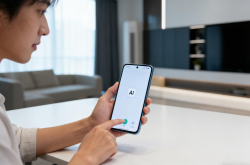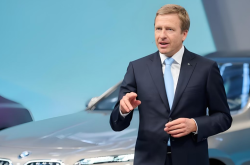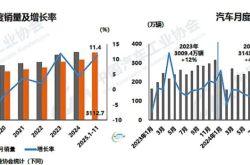Three major pitfalls in new energy vehicle after-sales, how many have you fallen into?
![]() 07/25 2024
07/25 2024
![]() 446
446
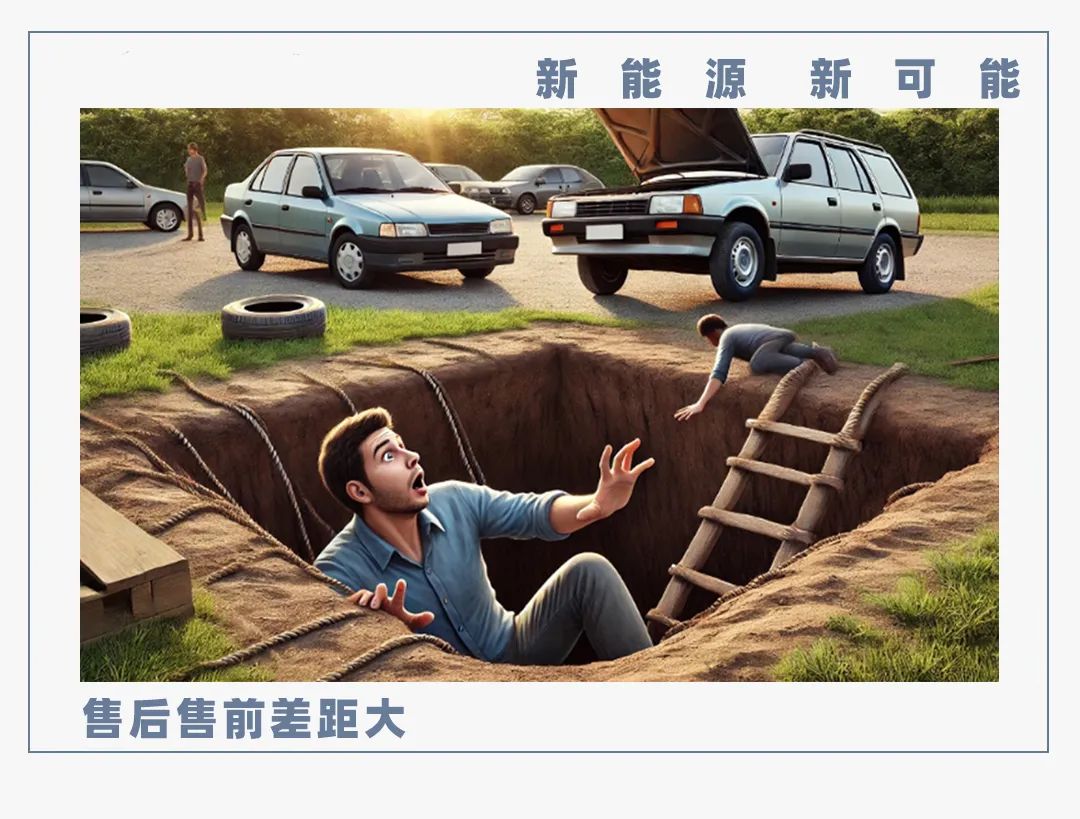
Original content from New Energy Outlook
According to the latest data, out of every two cars sold in China, one is a new energy vehicle. Consumers have many reasons for choosing new energy vehicles, and "saving money" is definitely one of the major factors.
However, the reality is that due to differences in after-sales services compared to traditional gasoline vehicles, new energy vehicles have caused numerous consumers to suffer, with higher costs being borne in reverse.
Therefore, whether it's consumer service platforms like Chezhi.com or Heimao Complaints, complaints about the "after-sales" of new energy vehicles remain high. Even for issues that cannot be resolved online, consumers have resorted to extreme measures such as hanging banners outside 4S stores and spray-painting cars, often resulting in a lose-lose situation for both parties.
New Energy Outlook has contacted several new energy vehicle owners, and the most common issues they feedback are scams related to lifetime warranties offered by new energy vehicle manufacturers, excessive repairs, and disputes over spare parts.
Undoubtedly, the new energy vehicle industry is still in its growth stage and needs the support of consumers. If car manufacturers start to play tricks with consumers, their own path will become narrower.
Lifetime Warranty: A Full-fledged Word Game of Tricks
The new energy vehicle market is fiercely competitive, and many car manufacturers have introduced lifetime warranty policies. However, in practice, such promises are often accompanied by a series of conditions, making "lifetime warranty" not as beautiful as it sounds, seemingly turning into a heavily conditional word game.
For example, as early as June 2022, BYD made headlines due to the terms of its "lifetime warranty for the three-electric system." At that time, some netizens claimed that "replacing a non-original screw would disqualify the vehicle from the lifetime warranty."
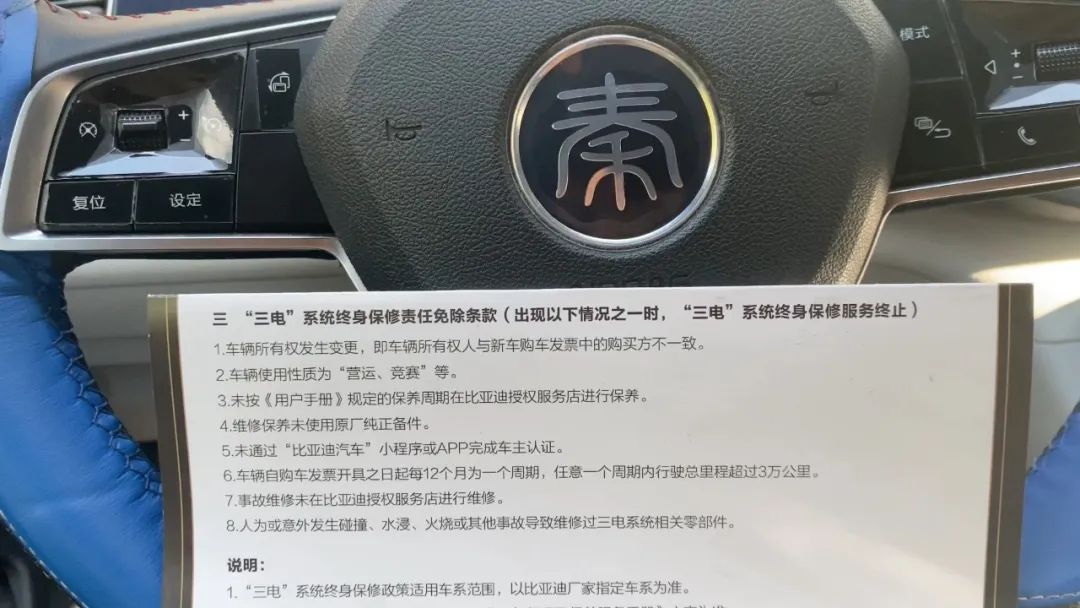
Image/Partial agreement for "lifetime warranty of the three-electric system"
Source/Screenshot from New Energy Outlook on the internet
Not long ago, BYD was once again pushed into the spotlight due to its lifetime warranty. Many BYD owners reflected on online platforms that while BYD batteries are advertised as "lifetime warranty" and "free replacement," they are actually full of tricks.
BYD's official response was that since the three-electric system involves high-voltage safety, unauthorized repairs and the use of non-original parts could pose serious safety hazards, thereby affecting the lifetime warranty rights of the three-electric system.
In fact, it's not just BYD; many car manufacturers, including Chery, LYNK&CO, NIO, and Li Auto, have introduced lifetime warranty benefits for the three-electric system or the entire vehicle. Upon reviewing each company's lifetime warranty policies, the following restrictive conditions can easily be summarized:
First Owner Restriction: Many brands' lifetime warranty policies are limited to the first owner of the vehicle, meaning that once the vehicle is sold, the new owner will no longer enjoy the benefit.
Usage Conditions: Lifetime warranties may only apply to non-commercial vehicles, i.e., private cars, and do not include commercial vehicles such as ride-hailing cars.
Maintenance and Repair Requirements: To maintain the validity of the warranty, owners are required to conduct regular maintenance and all repairs at designated 4S stores, and all parts must be original, or the lifetime warranty may be invalidated.
Accident and Modification Restrictions: After a major traffic accident, even if the vehicle is repaired, the lifetime warranty for the battery may be invalidated. Additionally, any unauthorized vehicle modifications may violate the warranty terms.
Geographical Restrictions: Certain warranty policies may only be valid in specific regions, and if the vehicle is moved from one region to another, the warranty may no longer apply.
Normal Wear and Tear: Warranties typically do not cover component wear caused by normal wear or aging, which may include natural degradation in battery performance.
Complexity of Battery Packs: Even if the battery cells enjoy a lifetime warranty, other components within the battery pack (such as the Battery Management System (BMS) and cooling system) may not be covered by the lifetime warranty.
In the opinion of Zhang Hong, Secretary-General of the New Energy Branch of the China Automobile Dealers Association, it is understandable for car manufacturers to introduce various promotional measures, but they should not restrict the rights and interests of car owners. For example, tying maintenance to factory-designated 4S stores and imposing restrictions on vehicle usage are bound to cause dissatisfaction among consumers.
Thus, although lifetime warranties sound reassuring in marketing materials, potential car owners should carefully read and understand the specific terms and conditions of the warranty to avoid unexpected repair costs in the future. When purchasing a new energy vehicle, it is best to consult professionals, fully understand the details of the warranty policy, and consider whether these restrictions align with your usage scenarios and purchase expectations.
Replace Instead of Repair, Treating Minor Injuries as Critical Illnesses
Consumers' initial intention in purchasing new energy vehicles is to reduce usage costs, and charging is indeed cheaper than refueling. However, from the perspective of repair costs, this is often not the case. Some repair costs are even astronomical, making them the "new energy assassins" of the repair industry.
Consider this real-life case: A Polestar 2 suffered a scratch and collision during driving, resulting in damage to the headlights and chassis, and a dented battery plate. After being sent for repair, the total price of the new car was less than 300,000 yuan, but the 4S store quoted a repair price of up to 540,000 yuan. Among them, the repair cost for the front of the car and headlights was over 90,000 yuan, while the chassis section required the replacement of the entire battery pack, costing more than 400,000 yuan!
When an Ora Good Cat owner in Tengzhou, Shandong, entered an underground garage, the raised drainage cover scratched the battery pack. After the car was towed to the 4S store for inspection, the quoted battery repair and replacement cost was as high as 101,600 yuan. The owner stated that the car was purchased in 2021 for just over 110,000 yuan, and the repair cost was almost catching up to the purchase price!
A Tesla Model Y owner hit a wall while reversing, and after consulting Tesla's after-sales service and being assessed by the insurance company, the repair cost was close to 200,000 yuan. The Model Y was purchased for only 280,000 yuan, and the repair cost exceeded 70% of the new car's price!
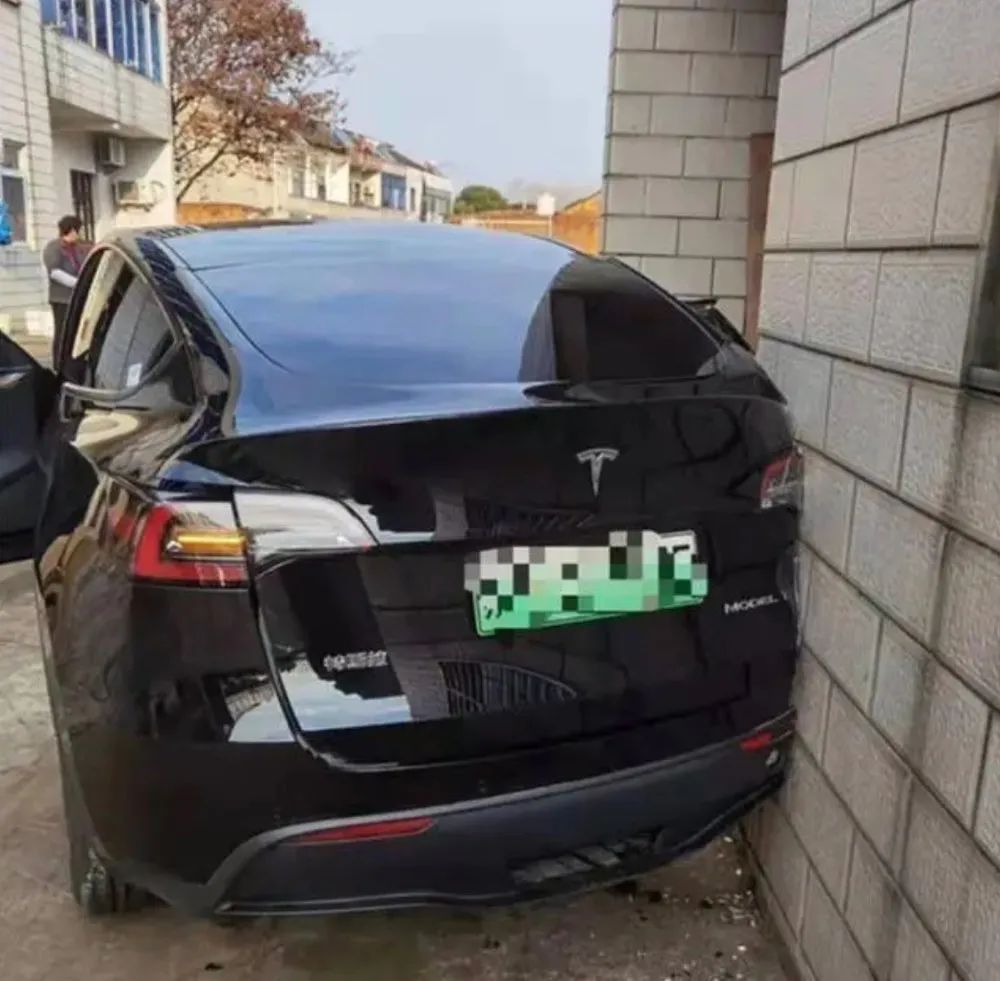
Image/Car owner backing into a scratch
Source/Screenshot from New Energy Outlook on the internet
Why does this phenomenon occur?
Compared to gasoline vehicles, new energy vehicles employ cutting-edge technologies such as electric motors, battery packs, and charging piles, especially battery technology, which has become an important reason for the higher repair costs of new energy vehicles. Additionally, the integrated advanced sensors and electronic equipment are also very expensive to repair and replace.
For example, the repair cost for a single lidar sensor in the XPeng P5 exceeds 9,000 yuan. The XPeng P5 is equipped with four lidar sensors around its perimeter, and the cost of lidar sensors plus their housings could almost buy 0.43 cars. Such a terrifying parts-to-whole car ratio is comparable to that of first-tier luxury brands.
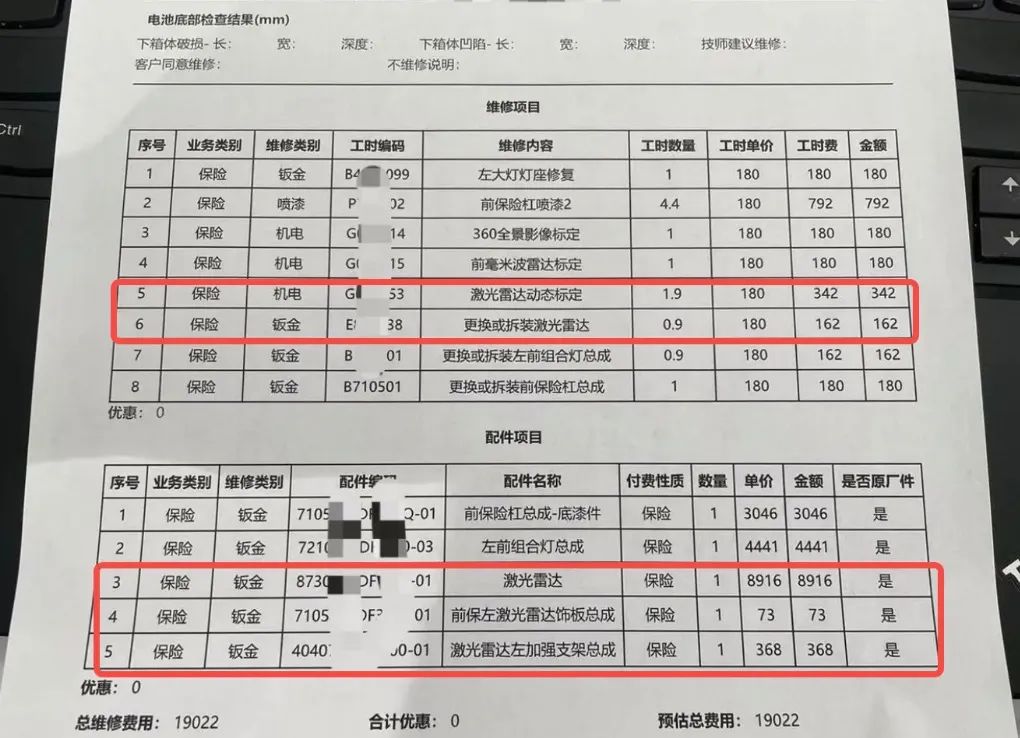
Image/XPeng repair bill
Source/Screenshot from Chen Zhihao Aries's Weibo and New Energy Outlook
The difficulty of repairs is also a reason for the high repair costs of new energy vehicles. Currently, the three-electric repairs of many new energy vehicles are basically monopolized by 4S stores, and some even need to be sent to more specialized repair stations for inspection and repair. Coupled with the tendency to replace rather than repair, directly installing new assemblies, such a repair environment certainly pushes up consumers' repair costs.
So are there any good ways to help car owners avoid pitfalls?
The maintenance of new energy vehicles must be done properly. Owners must strictly follow the requirements in the vehicle manual and conduct regular maintenance, as well as properly manage battery charging and discharging, to effectively extend battery life and avoid unnecessary repair expenses.
Additionally, it is essential to purchase sufficient insurance, with vehicle damage insurance being a must. Furthermore, by purchasing extended warranties or maintenance insurance, the economic pressure caused by repairs can be effectively reduced.
Car Owners Self-Mockingly Call Themselves "Wronged": The Car is Still There, But the Car Manufacturer is Gone
Of course, avoiding some car manufacturers with poor sustainability when purchasing new energy vehicles can also help avoid many pitfalls.
"I didn't listen to people's advice, and buying this car was a huge mistake!" Mr. Yao, a WM Motor owner in Beijing, curses himself every time he sees the "four rings" he passed up two years ago while driving his WM Motor car.
This WM Motor car, purchased two years ago for 220,000 yuan, was only offered a trade-in price of 60,000-70,000 yuan by used car dealers. Selling it would mean a huge loss, but not selling it means dealing with frequent problems without anyone to turn to for help.
Neither selling nor keeping it seems like a good option, and now this "chicken rib" is miserably parked in an auto repair shop. Minor issues like strange noises can be tolerated, but major safety issues like battery overheating faults cannot be ignored. After finding a repair shop that could handle the repairs, the mechanic suggested, "Try replacing the compressor."
A friend asked, "Don't all cars come with warranties? Why not go to the 4S store for this car that's only two years old?"
"The manufacturer has gone bankrupt, where are the 4S stores? They're all closed!" Mr. Yao lamented.
He had previously inquired with other brands' 4S stores that had taken over WM Motor, and the staff said they could do the repairs, but it would take at least a month to wait for inspections to determine the problems before discussing repairs and parts.
If no parts can be found on the market, he has already thought of teaming up with other WM Motor owners to find an unsold complete WM Motor car and dismantle parts from it for everyone to replace.
How many "abandoned" WM Motor owners are there? Wang Du, Assistant Secretary-General of the China Automobile Dealers Association, revealed in an interview with the media that according to the association's statistics, there are currently over 160,000 existing car owners involved with new energy vehicle manufacturers that have applied for bankruptcy or have not produced for a long time, with WM Motor accounting for about 110,000 of them!
According to official information, WM Motor was founded in 2015 and is headquartered in Shanghai. The company's name is derived from the German word "Weltmeister" (World Champion), positioning itself as a provider of emerging new energy vehicle products and travel solutions in China.
On the still-accessible WM Motor official website, clicking on "Store Locator" results in a "Page Temporarily Unavailable" message after a few seconds of loading.
"Many WM Motor stores have closed down, including the one where I bought my car. I still have three unused maintenance coupons, but they won't let me use them anymore. Calling the official customer service number says they're still operating normally, but maintenance issues can only be negotiated with the store, but all store contact information on the app is disconnected," said a WM Motor W6 owner in Ningbo, Zhejiang, on a complaint platform.
In fact, as early as November 2022, there were rumors online that WM Motor had started cutting salaries, laying off employees, and closing stores. On October 10, 2023, WM Motor Technology Group Co., Ltd. applied for bankruptcy reorganization, with the applicant being WM Motor itself. The latest news is that due to failure to disclose annual reports as required, WM Motor was listed as abnormal in business operations by the Shanghai Qingpu District Market Supervision and Administration Bureau on July 1.
In fact, the situation of cars still being driven while car manufacturers go bankrupt is not an isolated case. On July 11, Anhui Qidian Intelligent New Energy Automobile Co., Ltd. was also listed as abnormal in business operations due to failure to disclose annual reports. Public reports indicate that Qidian Automobile went bankrupt on April 9 of this year.
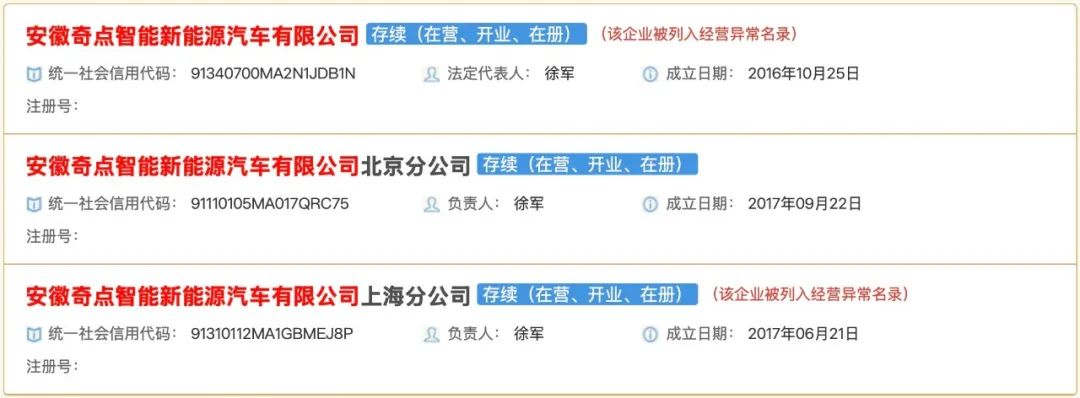
Image/Current status of Anhui Qidian Intelligent New Energy Automobile Co., Ltd.
Source/National Enterprise Credit Information Publicity System Screenshot from New Energy Outlook
According to incomplete statistics, brands such as HiPhi, Evergrande, Yudo, Hanteng, and Aichi, which were once renowned, have all struggled to continue operations.
As the elimination race among new energy vehicle manufacturers intensifies, those lacking product advantages and technological barriers may face significant survival challenges in the future. And those car manufacturers that fail by playing tricks on consumers have only themselves to blame.
Lastly, what other issues have you encountered in the after-sales service of new energy vehicles? Welcome to share your experiences in the comments section.


